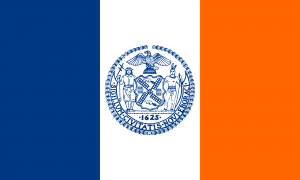David Amiel, Vincent Ren, Raina Vettithanam, Amanda Chan

The NYC flag consists of the colors blue, white, and orange. The middle of the flag features the city’s seal, which possesses various symbols, each with their own symbolic representations. There is a native, a sailor with navigational tools, a windmill, flour barrels, beavers, and an eagle. At the bottom of the seal is a date of significance, 1625, which shows when the colony was founded, and at the border are the latin letters spelling out: “Seal of the City of New York.”
Our artifact can be found in the City of New York, and is on display outside all government and public buildings in the city. The flag was adopted by the city in December of 1977, although a variant of the flag exists at the mayoral office, which has five stars placed directly above the seal. The flag features many symbols which demonstrate the intimate connection between New York City and the Dutch. Looking closely at the seal, the beavers inside the coat of arms represent the Dutch East India Company, the first trade company to open trade to the city. Other Dutch influences can be seen inside the seal as well. For example, the windmill fans which divide the seal represent the prosperity of the flour-milling industry, whose prosperity directly affected the economic success of New York City, at the time, the New Netherlands. Furthermore, the figure on the left of the seal is a colonial seaman, which also points to the Dutch’s founding of New Amsterdam; to his right is a native, which represents the original indigenous population.
This intertwining of histories resonates with many people, considering the population of the city. The flag, which is a symbol of the city, and in the past, a source of great pride for its inhabitants, is a reminder of the city, and the country’s, connection to the Dutch. The year 1625, which is printed in the city’s seal, is the year in which New Amsterdam was founded by the Dutch. Although hundreds of years have gone by, the flag is still a present-day reminder of the city’s roots.
We chose this artifact because of its abundance of connections to our inter-woven histories with the colonial Dutch. New York City is close to home for many Rutgers students, and its influence extends well beyond the city’s borders. In investigating the influence that the Dutch had on New York City, the cultural center of our country, we were able to see not only that much of our colonial history and prosperity is due to the Dutch – specifically the Dutch East India Trading Company – but to appreciate the deep connections that exist between our two societies.
External Sources:
NYC Green Book Highlights - City Seal and Flag The Official New York City Flag

